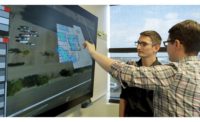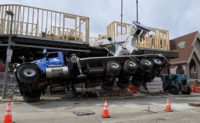Many modern robots function within highly controlled surroundings, like the factory or even the home (think Roombas).
But how would automatons fare and function in the complex environment of a construction site? What traits would they need to operate in a place where workers, vehicles and materials are constantly moving, where the landscape itself is changing as structures rise and grow?
These are the questions we’re exploring at the University at Buffalo.
With a team of architecture and engineering experts, we’re prototyping a series of On-Site Construction Robots (OSCR). The research is led by Karthik Dantu and Nils Napp, two computer science and engineering faculty members at UB, and myself.
Our project is still in its early stages, but our goal is to create a ladder-climbing helper droid that serves as a mason’s assistant. Its main job: hauling heavy materials to craftsmen working up high, on rooftops or scaffolding.
In the future we envision, masons would tell the robots exactly which materials are needed and where through a pair of “smart glasses” that 3D-scan the construction site. The glasses would then transmit the information offsite to the developer or architect monitoring the project.
The robots would enable masons to focus more on their craft by automating the tedious, physical work of moving bricks or stones on a construction site.
It’s important to note that our idea is not for our OSCR models to replace the mason. Instead, the bots would be there to assist the craftsmen in their daily work.
This reflects a direction that’s being taken in robotics in general. The focus has been shifting from robotics to co-robotics, where robots have a symbiotic relationship with humans, helping people instead of taking over their jobs.





Post a comment to this article
Report Abusive Comment